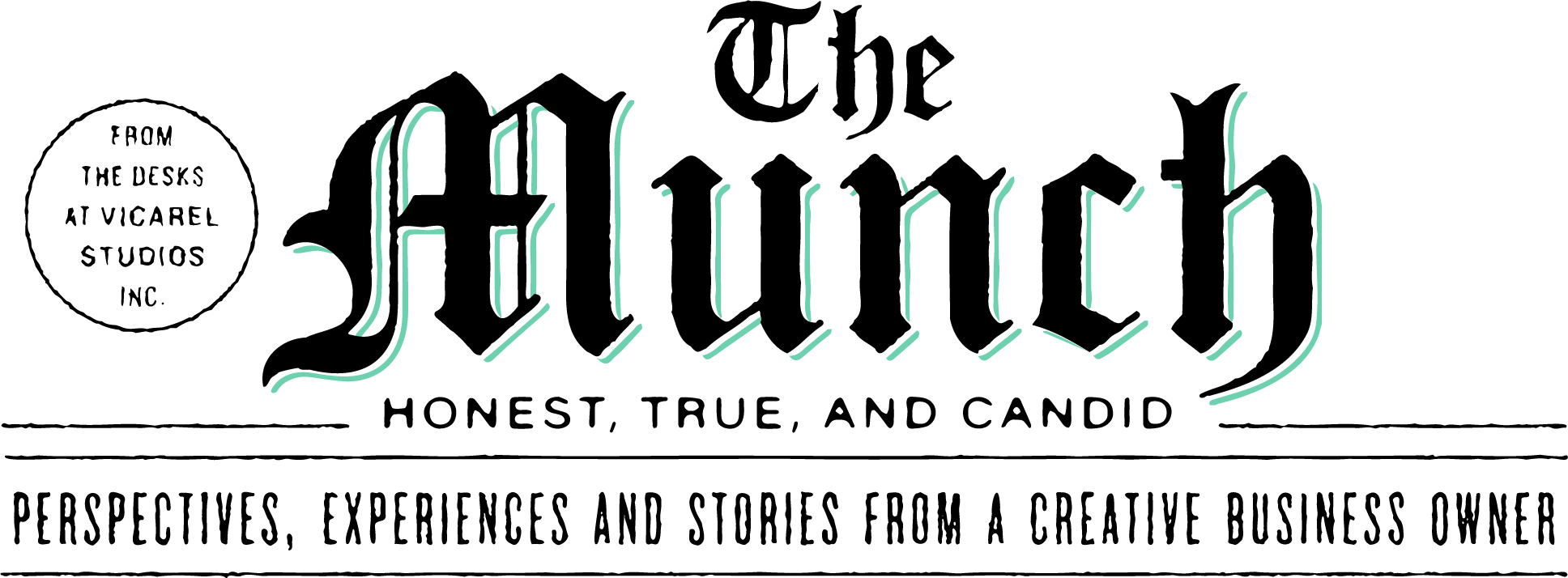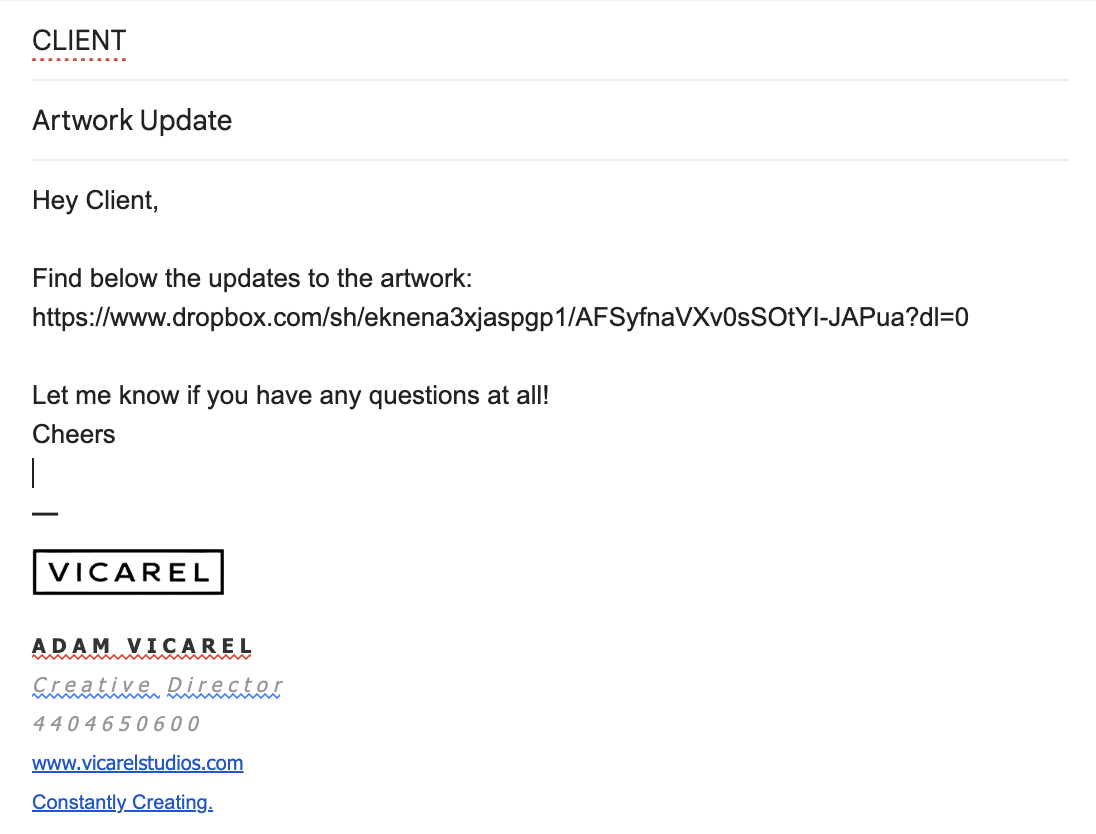Client File Management For Graphic Designers: Why You Should Use Dropbox Instead Of Email Attachments For File Sharing.
Vol. 099
Client File Management For Graphic Designers: Why You Should Use Dropbox Instead Of Email Attachments For File Sharing.
You don’t send your mail with a carrier pigeon, stop emailing your files like a neanderthal.
Email attachments are a logical way to get your files over to your client.
However, as file sizes continue to grow, email chains become longer, and the world continues to move faster, sending attachments via email is no longer the most efficient way to share files.
Here are three reasons why you should consider sending cloud-based links (we use Dropbox) to your file instead of email attachments for file sharing, as well as how exactly we do it.
Sending emails with attachments bogs down email chains
Email chains can quickly become unmanageable when there are multiple large attachments being sent back and forth. The larger the attachment, the more it slows down the email chain.
We’ve all been in that email chain that’s 140 messages long, and as soon as you get into it, your computer lags harder than having the entire Adobe Creative Suite open.
A laggy email chain can lead to frustration for everyone involved, as it becomes harder to keep track of the conversation as well as the important details that can get lost in the noise.
As a well informed graphic designer, it is your responsibility to be up-to-date on best practices like file management. By using cloud-based storage, like Dropbox, to store and share files, you can keep the email chain free of bulky attachments and movin’ quickly.
Sending emails with attachments fills up your email server space
Many email providers offer limited storage space for users. Have you ever received the “it looks like your email is almost full” — or even worse, “your storage is full and you can no longer send and receive messages.”
Graphic design presentations are often multiple MB in size. When you send large attachments via email, you quickly eat up this storage space.
Instead of purchasing additional storage space you can simply avoid wasting that precious space with email attachments.
Using Dropbox to store and share files, you can free up valuable email server space and ensure that your email account remains functional.
Dropbox allows for easy file updates
We once had a client go to print with the wrong file.
When asking them how it happened, they said that they had gone back to our email chain, downloaded the attachment, and sent it to print. Problem was, it was the wrong email chain and thus wrong attachment. 🤦
One of the biggest advantages of using Dropbox to store and share files is the ability to easily update files that have already been sent.
If you need to make changes to a file that you've already sent, simply update the file in Dropbox and send a new link to the recipient.
Or, better yet, we actually send a link to a folder, as opposed to a specific file, so if the file is updated we don’t even need to send a new link.
This is much easier than trying to resend an updated attachment, which can lead to confusion and errors, like what we experienced.
By using Dropbox, you can ensure that your files are always up-to-date and that the latest version is easily accessible to everyone who needs it.
It’s worth noting that your client might download the file from Dropbox. If that’s the case, updating the file on the Dropbox server doesn’t do anything to the file that’s already been downloaded.
How to use Dropbox to send files
Below is a really quick walkthrough of what this process actually looks like.
Firstly, our Dropbox is setup with two main sections:
1) Vicarel Studios’ Client Folders
These are our internal folders (only Vicarel Studios employees has access to these). Here, we store every file, asset and revision to every file we work on.
Shown above, our layout for all clients: _ClientsVS > Client Name > Project Name > Project Files.
2) Shared Client Folders
This is where we place any files that we’d like to share with our client (these are what you would have formally attached to an email). The project folder structure here is the exact same as _ClientsVS; however, we only place files in here that we want to share with our clients.
Shown above, our layout for all shared client folders: _SharedClient > Client Name > Project Name > Project Files.
In this example of a long sleeve t-shirt design for our client, Curation, I wanted to highlight one important detail.
If you share a link directly to a file (i.e., right click on a pdf in your _SharedClient folder, and select “share Dropbox link) that exactly file is linked as is. **If you update that file, even if has the same file name, the link you provided your client will break. It will no longer work.
To avoid this, we always link to a folder, with the file nested within it, as seen below.
*Note: If this were an email attachment, you’d be sharing the file WITHIN the folder that we’re creating the Dropbox link to. You should share the parent folder that holds the file.
Sharing a file this way allows you to continue to update the actual file within the folder without the link ever breaking.
We then send the link to our client in an email.
One additional step we like to take is utilizing a “_Previous” or “_OLD” folder. Simply, any time we update a version of a file, we move the old version into the “_Previous” folder, and allow the most updated file to be the ONLY thing in the main folder (see below.) We feel this is a best practice to allow for accountability, transparency and traceability of file evolution.
Using Dropbox instead of email attachments for file sharing has several advantages. It can help to streamline email chains, free up email server space, and make file updates easier and more seamless.
There are plenty of options for file management, but some of the best cloud storage for graphic designers is Dropbox, Google Drive, or iCloud.
By adopting this approach, you can improve your productivity, position yourself as a more intentional and educated graphic design professional, and you’ll make the file sharing process more efficient for everyone involved.
What do you think — are you gonna try it?







